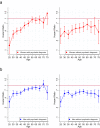Parenthood and lower risk of suicide in women and men: the total Swedish population followed across adulthood
- PMID: 35838797
- PMCID: PMC9636107
- DOI: 10.1007/s00127-022-02321-y
Parenthood and lower risk of suicide in women and men: the total Swedish population followed across adulthood
Abstract
Background: Previous studies suggest a protective effect of parenthood on suicide, but little is known about how the association may change across the lifespan, or in relation to sex, marital status or occurrence of psychiatric disorders.
Methods: We followed a cohort of over 5 million Swedish women and men, from 1991 to 2011, up to max. age 75, for death by suicide using national registers. Information on childbirths/adoptions, potential confounders and modifying factors were obtained from national registers. We assessed the associations between parenthood and suicide across adulthood using within time-stratified Cox regression models, with parenthood as a time-dependent exposure.
Results: Parents had a lower risk of suicide than non-parents across the lifespan, after adjusting for sociodemographic factors. The association was most pronounced in young adults, especially young women, but attenuated with increasing age and converged between sexes in older age groups. The lower risk of suicide over the life course was similar whether parents were married, unmarried or divorced, apart from married men; among them, parents only had a lower risk above age 55. The lower risk in parents was also evident in people with a history of psychiatric hospitalizations, but disappeared from age 55 in this population.
Conclusion: The lower risk of suicide was present in both parents, was most pronounced in young adulthood and weakened with increasing age. Our results are consistent with a plausible mechanism where feelings of responsibility and connectedness are protective against suicide in parents.
Keywords: Cohort; Epidemiology; Life course; Parents; Suicide.
© 2022. The Author(s).
Conflict of interest statement
The authors declare that they have no conflicts of interest.
Figures




Similar articles
-
Parenthood is associated with lower suicide risk: a register-based cohort study of 1.5 million Swedes.Acta Psychiatr Scand. 2021 Mar;143(3):206-215. doi: 10.1111/acps.13240. Epub 2020 Oct 19. Acta Psychiatr Scand. 2021. PMID: 33011972 Free PMC article.
-
Association of marital status with the incidence of suicide: a population-based Cohort Study in Japan (Miyagi cohort study).J Affect Disord. 2013 Sep 25;150(3):879-85. doi: 10.1016/j.jad.2013.05.006. Epub 2013 Jul 4. J Affect Disord. 2013. PMID: 23830860
-
Marital status, educational attainment, and suicide risk: a Norwegian register-based population study.Popul Health Metr. 2021 Jul 12;19(1):33. doi: 10.1186/s12963-021-00263-2. Popul Health Metr. 2021. PMID: 34247635 Free PMC article.
-
Suicide Around the Anniversary of a Parent's Death in Sweden.JAMA Netw Open. 2023 Apr 3;6(4):e236951. doi: 10.1001/jamanetworkopen.2023.6951. JAMA Netw Open. 2023. PMID: 37040117 Free PMC article.
-
Marital status and suicide in the National Longitudinal Mortality Study.J Epidemiol Community Health. 2000 Apr;54(4):254-61. doi: 10.1136/jech.54.4.254. J Epidemiol Community Health. 2000. PMID: 10827907 Free PMC article.
Cited by
-
"She Was Feeling Overwhelmed at Home Caring for Her Children": Expectations of "Intensive Motherhood" as a Risk Factor for Young Women's Suicide.Violence Against Women. 2025 Sep;31(11):2803-2829. doi: 10.1177/10778012241265365. Epub 2024 Jul 23. Violence Against Women. 2025. PMID: 39043125 Free PMC article.
References
-
- World Health Organization (2014) Preventing suicide: a global imperative. World Health Organization, Geneva
MeSH terms
Grants and funding
LinkOut - more resources
Full Text Sources
Medical

